Chicken meat is one of the most nutritious meals, especially since it’s packed with proteins, vitamins, and other minerals.
While most people enjoy eating chicken, not everyone can butcher one. Some people think the process of butchering a chicken is way too engaging and even inhumane but the truth is that once you get the hang of it, you’ll find it easy and less complicated.
Again, there are more humane ways to go about it so you don’t have to worry about putting your chicken through so much torture.
Ready to gain some skills? This guide contains a detailed process of butchering a chicken without contaminating it. Let’s dive right in!
Prepare The Set Up
You want to have all the equipment ready and get over with the activity as soon as possible. You also want to keep the chicken as clean and uncontaminated as possible. The idea is to have everything you need ready before getting started.
I usually boil my water, create a butchering platform depending on the number of animals I’m butchering and their size, bring a trash bin, have an extra tray or pot, a sharp knife, and lots of water for rinsing.
Tip: Plan ahead to make the process easy, fast, and to avoid contaminating your chicken with fecal matter.
Related: 26 Necessary Tools For Off-Grid Living
Catch The Chicken
I live on a farm where I allow my chicken to roam freely in a specific part of the garden. Normally, I’ll butcher a chicken that is older, not as productive, or simply one that is big enough to feed my household.
I know catching a chicken, especially, on an open farm can be challenging, but the classic method of tricking them with some seeds works perfectly fine.
Tip: To avoid the hassle of having to chase the chicken around, just isolate the chicken the night before and keep it in an enclosed space.
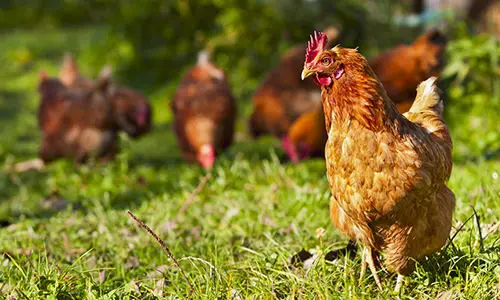
Remove The Head
This is usually the deal-breaker for most people.
Trust me, I wouldn’t eat chicken unless a farm hand helped decapitate it. The thought of having to hold it down used to scare me up until I learnt a trick I’ll share with you shortly.
Normally, the chicken keeps flopping after you cut its head off, which can freak you out if it’s your first time. To avoid such a scenario, keep holding the chicken upside down after cutting its head off. If possible, secure its wings too.
Tip: Secure the chicken after decapitating to prevent it from creating a messy scene with blood stains all over.
Related: 10 Common Mistakes You Should Avoid If You Want To Raise Chickens

Scald The Chicken
I normally use hot water between 120°F to 135°F. To avoid cooking your chicken, you need to keep the dunks very brief. Dunking the chicken, a couple will be enough.
If you are a beginner, don’t dunk the chicken immediately after cutting the neck. This is because the chicken might be having reflexes which could make it flop and splash the hot water on you.
Tip: Heat the water to the right temperature, keep the timing right, and immerse the entire carcass including its feet.
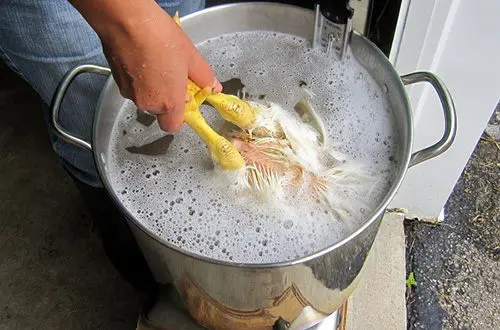
Pluck The Feathers Out
Scalding your chicken makes it easy for you to defeather it. Some people have a machine for this but I don’t have issues with plucking them manually. The hot water makes it easy for you to remove the pin feathers which can be such a pain.
If you scalded your chicken for too long in boiled water, you might notice some skin coming off when defeathering.
Tip: Keep the platform clean. This makes it easy for you to spot the parts of the chicken you haven’t plucked.
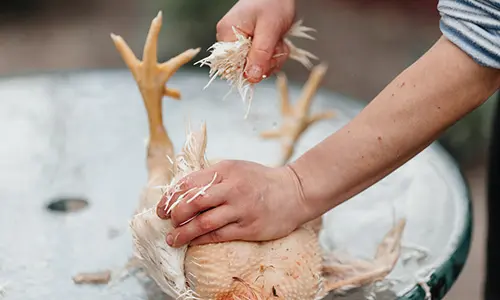
Singe The Carcass
Nobody likes having feathers and hairs on their chicken. Hairs are different from the feathers and plucking doesn’t work on them. Luckily, getting rid of them is not rocket science. Just hold the carcass on top of a fire to get rid of them.
Tip: Singeing is different from roasting, so keep it light and fast.
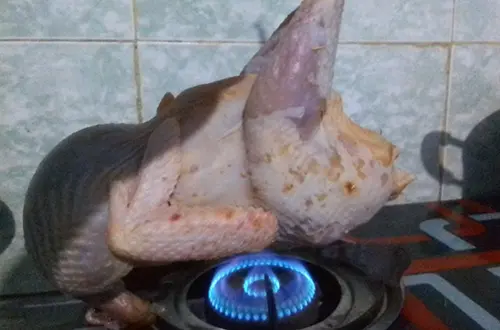
Remove The Feet
I normally serve the feet to my other farm animals as protein. Most free-range chickens have tough feet which will be hard to eat. They make great soup though.
To remove the feet easily, I normally bend the feet backwards to push the hock joints upwards.
Tip: Be sure to remove scales from the feet if you want to keep them and clean them thoroughly.
Cut Off The Oil Gland, Crop, and The Neck
The first thing you want to remove is the crop. This is the stomach of the chicken where all the food substances it consumed before you butchered it are deposited.
To remove the crop:
- Lay the chicken down on the chopping board on its back while stretching its neck out.
- Slice the neck halfway using a knife.
- Use your hands or the knife to loosen the skin around the neck to reveal the oesophagus.
- Pull the tube to get the crop.
Tip: To have a light crop with less food, isolate your chicken for a few days before butchering it and reduce its food intake.
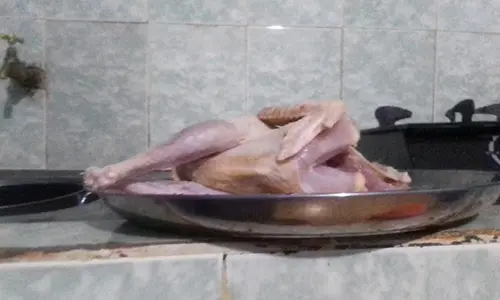
To remove the neck:
- Cut off the skin around the neck.
- Use the knife to break the soft bones on the neck just above the breast.
Tip: Cut the neck off after removing the crop to avoid spilling all the junk in that sac on your meat.
Related: The Dos And Don’ts Of Buying Livestock

To remove the oil gland:
- Lay the chicken on its breast and press it down on the chopping board.
- Use your knife to cut up to an inch of the tail off.
Tip: Throw the gland away. It’s too much oil and could be infected.
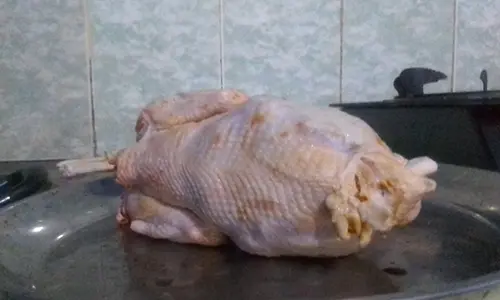
Remove the Gut
- Lay the chicken on its back and cut it open on the lower end just above the lower part of its breast.
- Insert your fingers into the opening and move it slowly to the neck end while tearing the membrane.
- Carefully pull the intestines out without breaking them.
Tip: Avoid breaking the guts before pulling them out to avoid tearing the gallbladder and spilling feces on your meat.
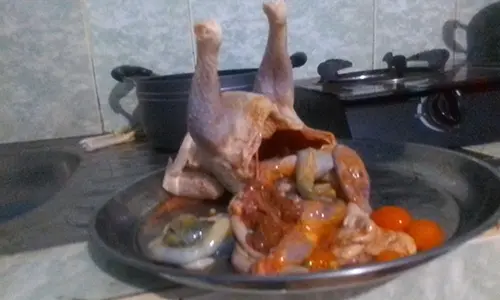
Cull The Giblet
Separate all the giblets: heart, liver, and gizzard from the other unwanted inner organs. Wash them thoroughly but carefully to avoid tearing them down into smaller pieces. Be sure to drain all the blood from the heart if you want to store the giblet for later.
Tip: Watch out for the gall bladder while separating. The bile is a nightmare. It can stain your hands and contaminate your meat.
Slice your chicken into pieces

Cut your chicken into quarters, the infamous 10 pieces, or any pieces of your choice.
Tip: Cutting through the joints makes the work much easier compared to slicing your chicken randomly.
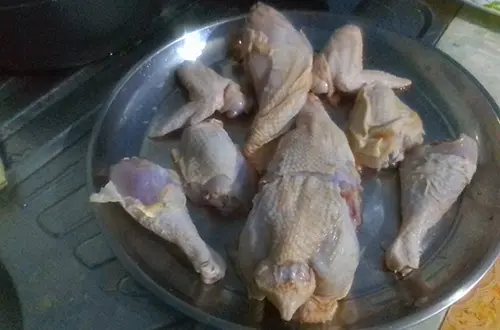
Once you’re done butchering your chicken, you can store it or chill it to cook later.
There are numerous recipes to try out with your nicely sliced chicken. You earned it!
You may also like:
 Making Machaca – Mexican Pemmican (Shelf Stable Meat)
Making Machaca – Mexican Pemmican (Shelf Stable Meat)
The Long-Lasting Food That Amish Pioneers Turned To In Dark Times (Video)
My Advice For All Homesteaders Out There

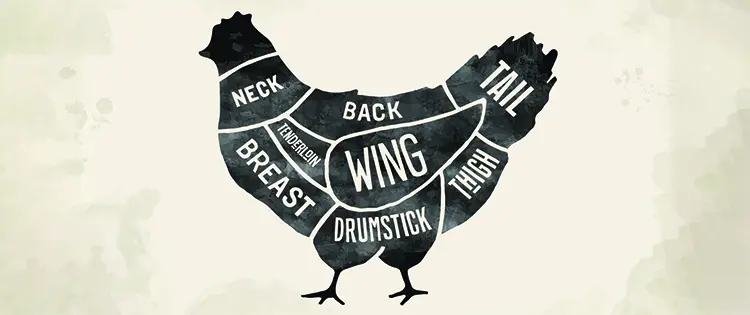








There is a humane way to kill a chicken that is quite easy to do, especially for someone who isn’t used to the blood and butchering. This prevents the “running around with the head cut off”.
First, get your station set up. You’ll need a plastic milk or juice gallon jug, a wooden post outside or somewhere you can nail the jug to and place a bucket under it. Then make sure you have a VERY, VERY SHARP filet knife to slice the blood vessel on the side of the chicken’s head. If the knife is dull it will be painful, which you want to avoid.
Next, take the plastic jug and cut around the hole with the lid to make it at least 3-4″ wide depending on the size of the birds you’ll be butchering; then cut off the bottom of the jug where you will insert the chicken, and nail the jug to the post with the large bottom opening UP, so you can put the dazed chicken in upside down. (the stainless steel funnels you can buy for this are very uncomfortable for the chickens and they sometimes fight it)
Pick up the chicken in your arms, grab its feet and pet it until it’s calm. Then turn it upside down hanging by its feet. The blood will rush to its head and it will become dazed. While the chicken is hanging upside down, insert it into the plastic jug and make sure the head in through the hole so the neck is exposed. Give it a few seconds to calm down if necessary. Then take the SHARP filet knife and quickly slice the blood vessel on the side of its neck and bend the head slightly to open the vessel and allow the blood to drain into a bucket. This gives the chicken a “comfortable” place to rest while its heart pumps out the blood and it dies HUMANELY.
After it is dead, cut off the rest of the head and proceed to the boiling water so it can be plucked. I learned to use 150-160 degree water with some Dr Bronners Tea Tree soap in it for its antibacterial properties, and wear heavy duty rubber gloves. I leave it dunked for 45-60 seconds. This eliminated the need to burn the little feathers because they came right off during plucking.
After plucking it clean I soak it again in clean water with some Dr Bronners Tea Tree soap in it. (NOT a lot of soap, just enough to make the water somewhat cloudy.)
From there cut it up the center of the breast side with poultry shears and butcher it as you prefer, making sure you get the crop and gizzard out before you cut it up.
This was learned from killing, plucking and butchering 90+ meat chickens with a friend who had raised them.